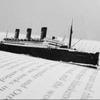This post is a lacking in many areas, but being pressed for time this will have to do. Any errors are my own. When visiting the Land of Spare Time I will be sure to come back to this post and recheck some facts with other sources.
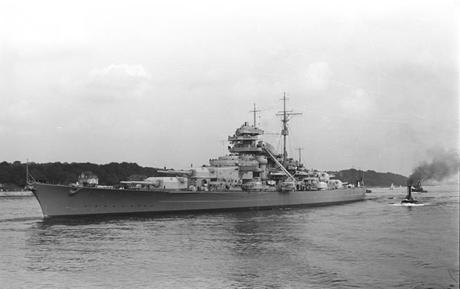
Bismarck (Credit: Wikipedia)
Her name was Bismarck. Big, fast and with an experienced crew the Allies had every right to fear her. The year was 1940 and it was only the year before Bismarck had been launched. Now she was preparing to break through British patrols and out onto the Atlantic where she could wreck havoc on Allied shipping. Along with Prinz Eugen, Bismarck set sail on 19 May beginning Operation Rheinübung. The next day the world was made aware that Bismarck was on the move after the Swedish noted the German vessels’ passing. It didn’t take long for the information to spread to the British Admiralty.
Great Britain was not going to sit back and twiddle its thumbs while waiting for Bismarck to find them. Instead they dispatched vessels to locate Bismarck. Air reconnaissance had turned up the ship’s position in Norway, but for how long she would remain there was unknown. The planes had not gone unnoticed by Bismarck. Despite poor weather conditions and ice encounters the Germans proceeded ahead. The Denmark Strait lay ahead and potential action with British ships (HMS Suffolk and HMS Norfolk were patrolling the area). Who would emerge the winner was a question that only time would answer. The Royal Navy vessels Hood and Prince of Wales had been dispatched to the Denmark Strait but it would be some time before they caught up to the Germans.
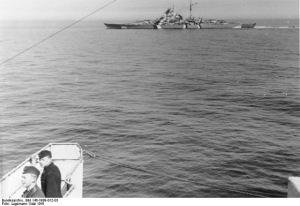
Bismark from Prinz Eugen (Credit: Wikipedia)
On 23 May Suffolk sighted Bismarck and Prinz Eugen. Prinz Eugen was to attack Suffolk but Suffolk took advantage of the foggy conditions and disappeared into the mist. Meanwhile a message was sent off informing the Admiralty of the sighting. Suffolk shadowed Bismarck while maintaining a distance between herself and the Germans, not wishing to engage them. Norfolk, on the other hand, ventured too close and took a beating before disappearing into the fog.
The next day Prince of Wales and Hood at long last arrived. Almost at once they engaged the German vessels; Hood firing on Prinz Eugen and Prince of Wales on Bismarck. Hood received the brunt of the fire enduring attacks from both of the enemy vessels. But it was Bismarck who delivered the devastating blow. A shell found its mark causing an explosion aboard Hood. A thick smoke enveloped the broken ship as her bow and stern both rose into the air before sinking out of sight. Of her more than 1,000 strong crew only three survived.
With Hood’s loss Prince of Wales now had to fend for herself. It wasn’t much longer before she retreated behind a smoke screen. After the skirmish, damage aboard Bismarck was assessed. Admiral Gunther Lutjens, in charge of Operation Rheinübung, decided to proceed to St. Nazaire where repairs would be made. The British were still tailing her, a task made somewhat easier now that Bismarck was leaving a trail of oil in her wake.
In the aftermath of Hood’s loss British ships were dispatched from all around to find Bismarck. On 25 May Bismarck was able to lose the British while out of range of their radar by slipping behind the vessels. Having lost her trail the British ships that had been tailing Bismarck spread out. When she was finally located by plane it showed that there was little hope that British forces would catch up to Bismarck before she reached the safety of her own. The last shreds of hope rested with aircraft carrier Ark Royal’s planes.
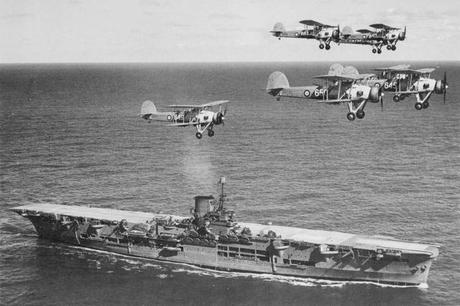
Ark Royal and Swordfish (Credit: Wikipedia)
After they pinpointed Bismarck on 26 May Swordfish planes returned to Ark Royal where they were armed with torpedoes (with magnetic detonators). Once in the air, the Swordfish mistakenly attacked HMS Sheffield. Fortunately, the magnetic detonators caused the torpedoes to explode prematurely. Sheffield was not hurt and it was a lesson learned. The Swordfish returned to Ark Royal where they traded what was left of their “faulty” torpedoes for torpedoes with contact detonators. This time their attack was to, a degree, a success. Two torpedoes found their mark with one doing serious damage to Bismarck’s steering. Among other things the port rudder was jammed. For awhile Bismarck sailed in circles, unable to escape from the enclosing enemy. Theirs was a lost cause which many were realizing, but there would be no surrender. Lutjen vowed they would “fight to the last shell”.
Controversy surrounds the events that followed next. HMS King George V and HMS Rodney closed in for the kill as they fired on the Bismarck. Shell after shell fell on Bismarck and yet there were no signs of German surrender. Fire had spread from one end to the other and the Bismarck was a complete mess. Yet she wouldn’t sink. With just enough fuel to get them home, the two ships withdrew while the HMS Dorsetshire moved in to torpedo the floating hulk. Aboard Bismarck orders were being given to abandon ship as scuttle efforts got underway. Bismarck eventually slipped beneath the waves never to rise again. but which method it was that actually sunk her is still up for debate.
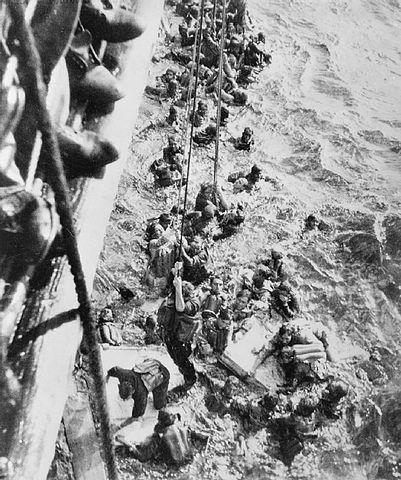
Survivors (Credit: Wikipedia)
Of the over 2,000 in crew, 400 were left on the surface. The British rescued 110 in all while the Germans later located 5 more survivors. Bismarck was gone and the intense search over. The wreck would remain hidden in the depths of the Atlantic until she was discovered in 1989 by Robert Ballard of RMS Titanic fame.
Source: Forrester, C. S. Sink the Bismarck! [Note: When I first picked this book up I had no idea it was somewhat fictionalized!]
